Hot Chips 2018: Nanotubes as DRAM from Nantero, a Live Blog
by Ian Cutress on August 21, 2018 1:40 PM EST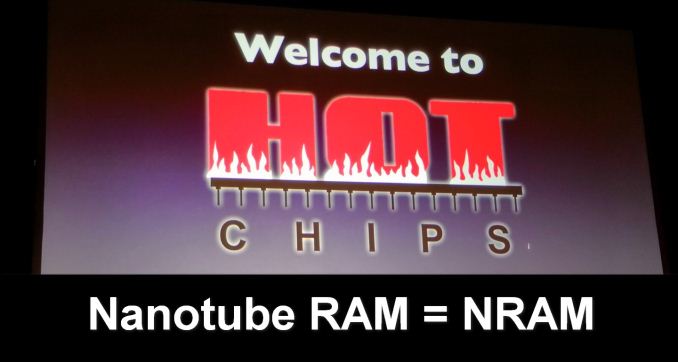
01:44PM EDT - Lots of different types of 'RAM' have been in the news, most noticably Intel's Optane memory and a couple of weeks ago at Flash Memory Summit we had the 'MRAM' Developer Day. At Hot Chips, Nantero is presentation about its new 'NRAM' technology, which uses carbon nanotubes. The talk is set to start at 10:45am PT.
01:47PM EDT - Carbon Nanotube Memory sounds sexy
01:47PM EDT - Go through Nanotubes to Memory in the talk
01:48PM EDT - A solution to replace DRAM
01:48PM EDT - 'Memory-class storage'
01:48PM EDT - Nantero is like Arm but for memory technology
01:49PM EDT - Specific details about marketing will depend on Nantero's customers
01:49PM EDT - Based on van-der-Walls effects
01:49PM EDT - Once connected, always connected
01:49PM EDT - Switched via electrostatic charges
01:50PM EDT - Use stochasic arrays of many nanotubes
01:50PM EDT - network of resistive elements
01:50PM EDT - an electrostatic force combines 1000 of cells together to lower resistance
01:50PM EDT - All the fun stuff happens at the bottom of the cell
01:51PM EDT - Part of the magic is how the nanotube is selected: length and diameter
01:51PM EDT - too long will short out the switch. too short will stand up
01:51PM EDT - Don't let the carbon nanotubes at the top to move
01:51PM EDT - manufacturing process is simple
01:52PM EDT - Build the logic you need, on any process or geometry
01:52PM EDT - expose contacts, spin nanotube slurry, and bake it. Metal, etch, and seal
01:52PM EDT - 10-to-1 set to reset states in resistance
01:53PM EDT - Begun analysis of Multi-Level Cells
01:53PM EDT - Look at MLC after SLC in production
01:53PM EDT - Scales down to 15nm
01:54PM EDT - consistent performance over billions of cycles
01:54PM EDT - Only temperature sensitivity above 300C, drops to 300 years. Otherwise 10000 years
01:54PM EDT - Believe it will scale to 5nm at a minimum
01:55PM EDT - Even at 1nm, have enough nanotubes to still change
01:55PM EDT - It's all about the length and diameter of nanotubes scaling
01:55PM EDT - Process agnostic
01:55PM EDT - on 28nm layer, 4Gb per layer in roughly 100mm2 die
01:55PM EDT - Also scale by adding layers
01:56PM EDT - Repeat nanotube deposit, metal, etch, deposit, metal, etch for layers
01:56PM EDT - Add layers of CNTs, or adding layers via TSVs
01:57PM EDT - Design for for DDR4 DRAM replacement device
01:57PM EDT - drop in replacement
01:57PM EDT - same timing, same perf, unlimited write endurance
01:57PM EDT - on 28nm, get 16Gb chip with 4 layers
01:57PM EDT - in a few years, easily 14nm or 7nm for 64 Gb / 256 Gb per die
01:57PM EDT - or add layers
01:58PM EDT - DDR4 to DDR5, whcih allows for additional die stacks
01:58PM EDT - Lots of capacity in every part
01:58PM EDT - NRAM is a storage class memroy
01:59PM EDT - NRAM is the only memory targeting a direct DRAM replacement
01:59PM EDT - unlimited endurance, same perf, better capacity, cheaper than DRAM
01:59PM EDT - Internal tiled architecture for memory
02:00PM EDT - Built in self-test and remapping logic for post-packaging repair
02:00PM EDT - SECDED engine in device
02:00PM EDT - in case problems with mass production - should increase yield and improve UX
02:01PM EDT - Aiming for DDR4 with ECC and to hit JEDEC standard on timings
02:01PM EDT - Decode logic in each tile with latching sense amplifiers
02:01PM EDT - Can do non-destructive read
02:01PM EDT - No things like pre-charge
02:01PM EDT - so faster :)
02:02PM EDT - Can now fit ECC into DDR4 timing easily due to no refresh
02:02PM EDT - 350ns to 0 ns
02:02PM EDT - DRAMs should be deterministic, but they're not due to refresh
02:02PM EDT - The DRAM should be ready when you need it
02:03PM EDT - Every 2 microseconds, need to refresh for 15% of the time
02:03PM EDT - This cuts into bandwidth
02:03PM EDT - So this is three grades of speed in DRAM terms
02:03PM EDT - Can build standard memory modules. They just work
02:04PM EDT - 128GB NRAM LRDIMM or RDIMM
02:04PM EDT - For comparison, persistence memory through NVDIMM-N. Enables flash and power supply
02:04PM EDT - Requires buffers
02:04PM EDT - Half-DRAM and Half-Flash
02:05PM EDT - shutdown and startup time could be two minutes on NVDIMM-N
02:05PM EDT - NVDIMM-P is similar, but still non-deterministic
02:05PM EDT - Still need power, buffers
02:06PM EDT - Persistent memory such as NRAM means no reloading on power fail
02:06PM EDT - or limited
02:06PM EDT - helps with uptime
02:06PM EDT - Today, power fail means checkpointing reload. NRAM doesn't need that
02:07PM EDT - Persistent memory is becoming more aware in software
02:07PM EDT - Persistent memory aware file systems and such
02:08PM EDT - All blocks and procedures are available for licencing
02:08PM EDT - Can be incorporated directly into silicon
02:08PM EDT - DRAM compatible front end possible
02:08PM EDT - On-the-fly ECC
02:09PM EDT - unlimited write endurance
02:09PM EDT - Memory-Class Storage
02:09PM EDT - Industry is ready
02:09PM EDT - Additional performance in DRAM mode
02:09PM EDT - Scaling in both stacks and process nodes
02:09PM EDT - Q&A Time
02:11PM EDT - Q: What you talk about is almost too good to be true. What am I missing? A: It does not go well with Peanut Butter or salsa. But seriously, we've built 1000s of test chips and we have profiled them. We haven't built 16 Gb device yet, it's up to the customer. Maybe it's that 300C limit that's the downside.
02:12PM EDT - Q: Do you have a metric for approximate energy per bit? A: I should have included it. Power conusmption has a major ripple effect. It runs off of the same power supplies, with the same or less energy as DRAM. 5 femto-joule per bit activation
02:13PM EDT - Q: A lot of data from individual die. Data over a large sample? A: We chose to pull single cell because it's more readable. The accumulated data on the 5ns access time, that was over billions of cycles on billions of devices.
02:16PM EDT - Q: NVM device, but haven't said about security? Encryption? Otherwise it's not a drop-in. A: We have these conversations with customers, We're an IP house - we do chip design. We had those discussions about each chip has encyption, but for the mainstream device, much like the NVDIMM-N, it's up to the system guys. The strong message we have from customers is to not screw with it - they'll deal with it. THey want dumb simple memory chips and their own security.
02:16PM EDT - Q: Alpha particle rate? A: These devices have been sent into space. We know about extremes, radiation. Nothing can you do to a nanotube to do something weird. We have electrostatic protection, nothing else seems to affect it.
02:18PM EDT - Q: You said nothing about the hammer to write the system. Said about alignment, but A: It's a complex formulation, some under NDA. We can discuss about the nanotube selection - part of our secret source is about the CNT slurry. We build that and licence that - they use our proprietary technology to do nanotube selection. Tuned to the cell, the length and diameter has be tuned.
02:19PM EDT - Q: How do you flip it? A: Electrostatics. Voltage across a word line, a bit line, we have some proprietary technology to prevent sneak. Writes are faster than reads because you just throw it down the line.
02:19PM EDT - Q: When do you thin we can install these devices in these systems? 2018? 2019? 2020? A: 2-3 weeks ago Fujitsu announced they were taking CNT to mass market. So you can buy those next year or the year after. It's all about fabrication and testing.
02:20PM EDT - That's a wrap. A super interesting talk for sure. The next live blog is at 2pm PT about Arm's Machine Learning Core.


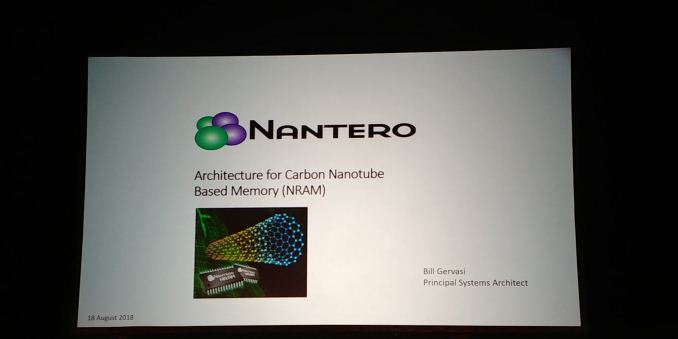
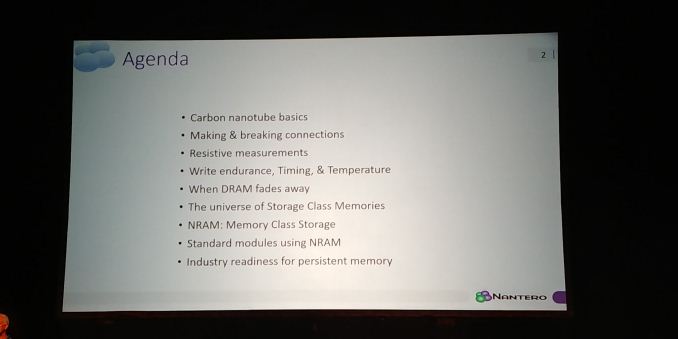
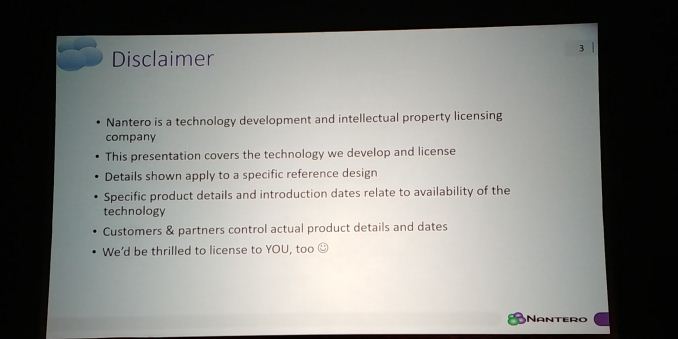


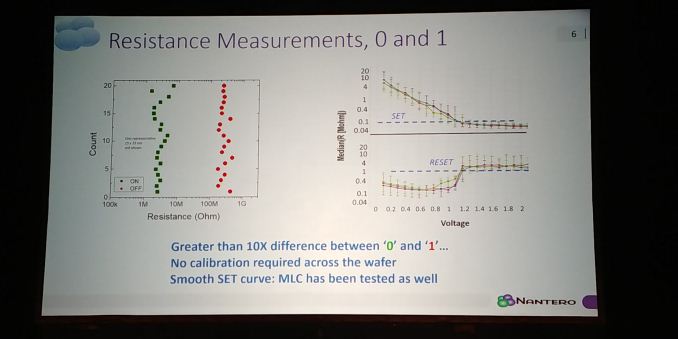
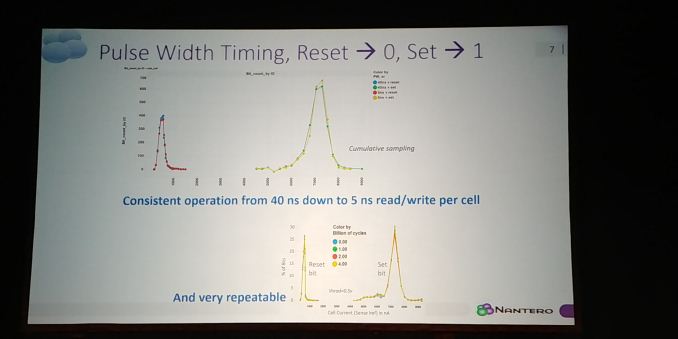

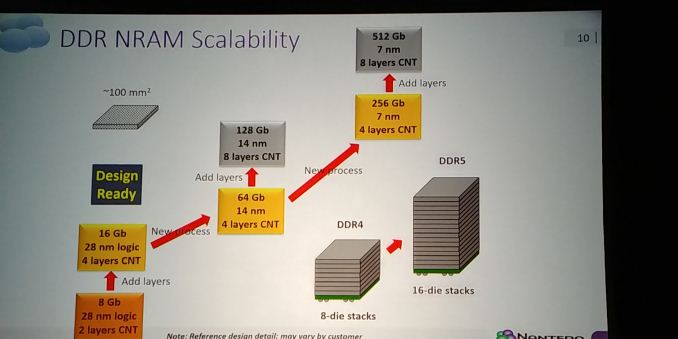
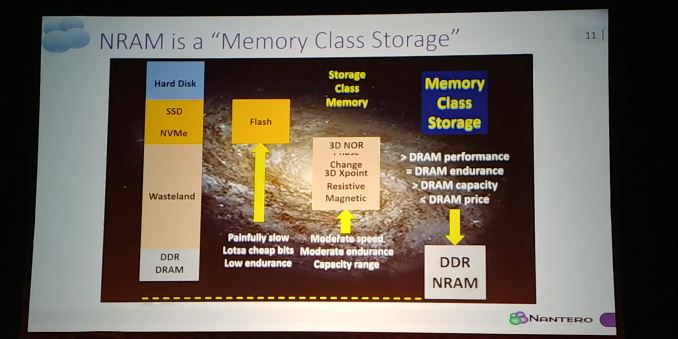
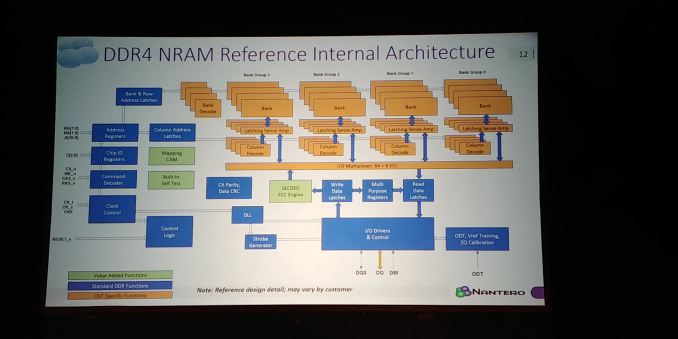
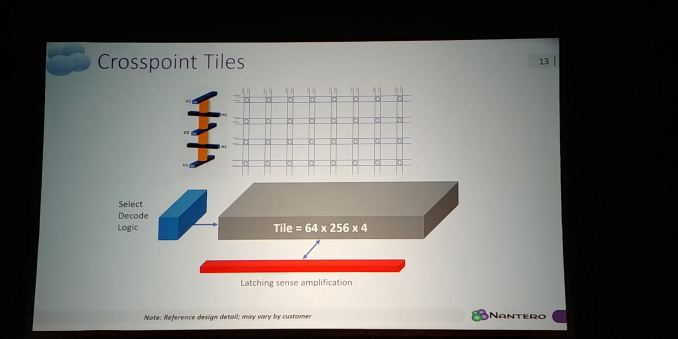
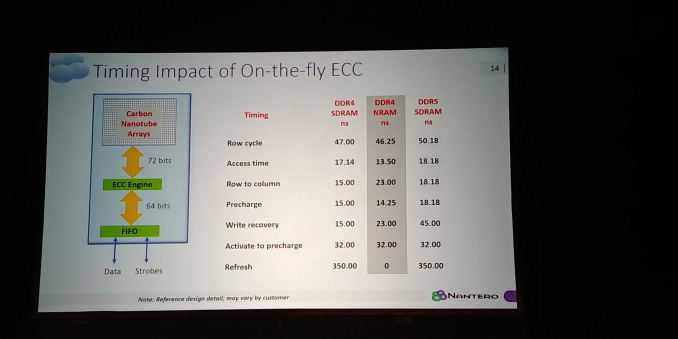
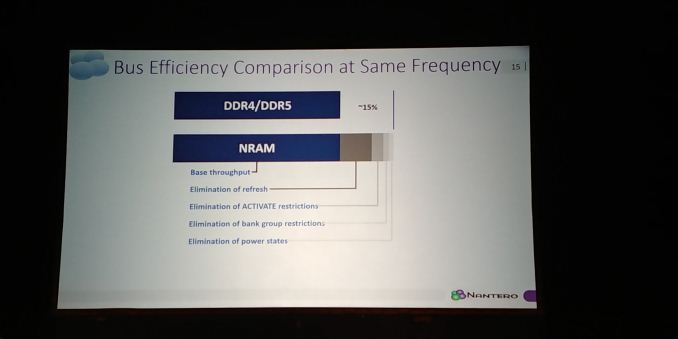
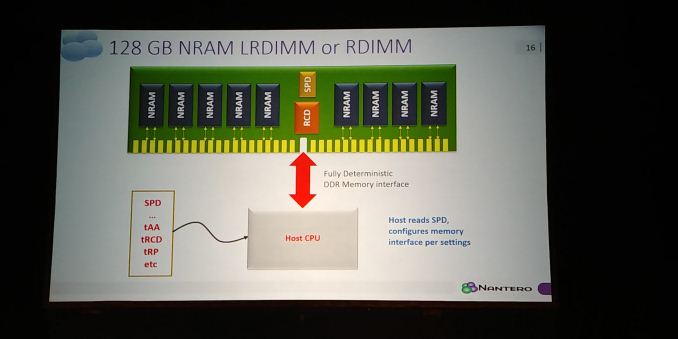
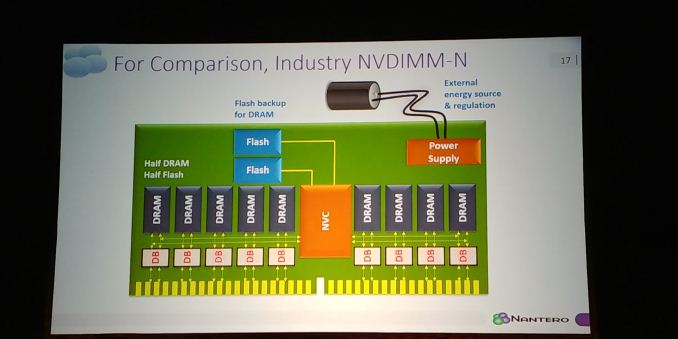
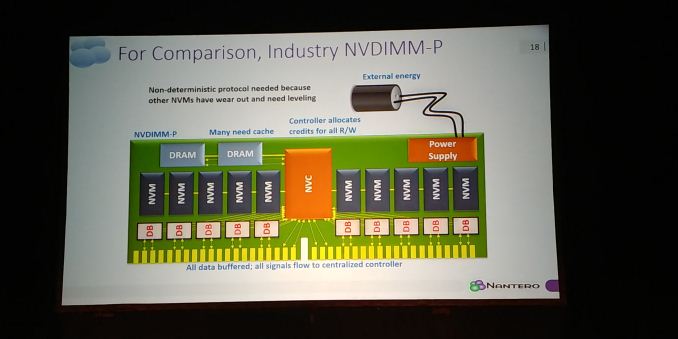
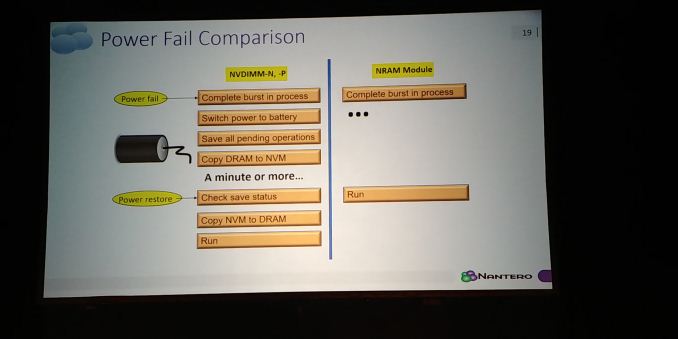

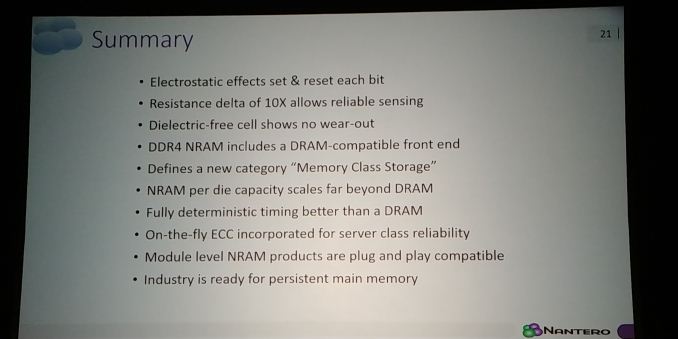








19 Comments
View All Comments
sgeocla - Friday, August 24, 2018 - link
If the technology is as good as it sounds I don't think there is any real chance of Intel being able to buy it. Natero being the first with this tech has the potential of taking over a large size of the memory market. And being a fabless company receiving royalties from every other memory or chip manufacturer It would basically be tens of billions in 5 years and probably more than Intel itself in 10 years.zapshere01 - Monday, December 31, 2018 - link
If memory serves (pun intended), this company was founded 17 years go. I have to believe that they have pitched this to (and been evaluated by) many companies both large and small.WatcherCK - Tuesday, August 21, 2018 - link
If production could scale to the point where the chip cost is properly cheap is there any reason why you couldnt load a system up with NRAM and run the system in a ram disk? for the business machines I roll out (8GB/256GB) if a system had 4 64GB NRAM modules and in UEFI I reserved 8GB for system and the rest for storage that would make for a very small for factor, same principle with laptops...I hope it isnt suppressed or purposely ignored, we wait and see who creates a fab and starts producing it at scale, perhaps the Chinese will spin up a couple of fabs for internal use they can afford to and if the benefits are to be believed would reap the benefits immediately. Western markets are hyper competitive battlegrounds I dont see NRAM breaking into that market certainly not in anything other than niche areas, definitely not on the desktop :( Europe would be the big unknown, I dont follow nm scale fabrication to any great degree but i remember reading about AMD having a fab or two in continental europe presumably there are other companies who mine chips there as well?
Gc - Thursday, August 23, 2018 - link
NRAM is based on the positions of carbon nanotubes -- touching or not. How sharp an external force would change these positions?Imagined downside: could NRAM be corrupted by an earthquake? (so not permanent for servers in the ring-of-fire? But it survived rocket lift-off?) A dropped phone? A vehicle crash? (so not for 'black-box' recorders in computer controlled vehicles?) Imagined upside: is it reliably erased by impact? (so maybe dud smart munitions are rendered dumb?)
abufrejoval - Friday, August 24, 2018 - link
This looks even better than MRAM in terms of density and 3D scaling.And you can build HBM out of this, potentially with higher stacks, as the energy density will be lower, no refresh.
I wonder if they can mix with logic as well as MRAM to give almost NV-logic with caches or even register files built out of CNT?
Can't wait to see this happen, too bad all my current stuff is DDR3 (DRAM recycling ;-)
zapshere01 - Monday, December 31, 2018 - link
One big question is the cost of the CNT layer (and there are multiple layers based in the presentation). In any commodity semiconductor segment, cost is the driver. You might have the best widget it town, but if it's expensive, then it better offer some amazing benefits over the existing technology, and even then, it might end up being a niche play since the current product base is heavily biased towards the existing technologies (NAND, DRAM, SRAM).iwod - Friday, August 24, 2018 - link
This thing is far too good to be true, surely something is missing? Even if it made DRAM persistent would have been a huge breakthrough, but it is talking about increase in capacity to something ( I assume ) like Die stacked SLC NAND, lower power, with ECC while being faster.alex_d - Monday, August 27, 2018 - link
A quick look on WIkipedia shows they've been trying to sell these for well over a decade. "2-3 weeks ago Fujitsu announced they were taking CNT to mass market." Actually, the deal with Fujitsu goes back to 2016. It is strange that in the presentation, Nantero revealed that a 16 Gb device hasn't been built yet. Back in 2016, the plan was to be manufacturing 256 Gb devices this year. https://www.theregister.co.uk/2016/08/31/nram_dev_... I wish them luck. Surely, the skyrocketing price of DRAM last year bolstered NRAM's value proposition.Anymoore - Friday, September 7, 2018 - link
I see a big problem that their SET and RESET voltages are so close.